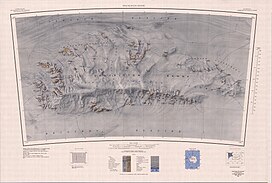| Du Toit Nunataks | |
|---|---|
 Shackleton Range, Read Mountains in lower right Shackleton Range, Read Mountains in lower right | |
| Highest point | |
| Elevation | 1,362 m (4,469 ft) |
| Geography | |
 | |
| Range coordinates | 80°43′S 25°50′W / 80.717°S 25.833°W / -80.717; -25.833 |
The Du Toit Nunataks (80°43′S 25°50′W / 80.717°S 25.833°W / -80.717; -25.833) are a group of nunataks between Cornwall Glacier and Glen Glacier, marking the western end of the Read Mountains in the Shackleton Range of Antarctica.
Names
The Du Toit Nunataks were photographed from the air by the United States Navy, 1967, and surveyed by the British Antarctic Survey, 1968–71. In association with the names of geologists grouped in this area, they were named by the UK Antarctic Place-Names Committee after Alexander Logie du Toit, a South African geologist.
Location
The Du Toit Nunataks lie to the south of the Shotton Snowfield to the west end of the Read Mountains. They lie between the Cornwall Glacier and the Glen Glacier, both of which flow south to join the Recovery Glacier, which flows westward past the south of the Du Toit Nunataks.
Geology
The Du Toit Nunataks are in the Read Group of the southern belt of the Shackleton Mountains. They are mainly composed of partly migmatised quartzitic, basic, calcareous and pelitic rocks. In places they are interlayered with gneissic granites, and intruded by granites and basic rocks. Dating of the metagranites gives ages of around 1,760 and 1,600 million years. Rb–Sr and K-Ar mineral cooling ages are 1650–1550 million years.
Features

Download coordinates as:
Named geographical features on the 1983 United States Geological Survey map include:
Hatch Plain
80°44′S 25°36′W / 80.733°S 25.600°W / -80.733; -25.600. A small debris-covered area with elevation about 1,350 metres (4,430 ft) on the east margin of Du Toit Nunataks, Read Mountains, in the Shackleton Range. Photographed from the air by the U.S. Navy, 1967, and surveyed by BAS, 1968-71. In association with the names of geologists grouped in this area, named by the UK-APC in 1971 after Frederick Henry Hatch (1864-1932), British consulting geologist; author of standard textbooks on igneous and sedimentary petrology.
Poldervaart Edge
80°44′S 25°57′W / 80.733°S 25.950°W / -80.733; -25.950 An east-facing escarpment rising to about 1,300 metres (4,300 ft) and trending northeast–southwest for 3.5 miles (5.6 km) in the Du Toil Nunataks, Read Mountains, Shackleton Range. Photographed from the air by the U.S. Navy, 1967, and surveyed by BAS, 1968-71. In association with the names of geologists grouped in this area, named by the UK-APC in 1971 after Professor Arie Poldervaart (1919–64), Dutch petrologist known for his research on basaltic rocks.
Spath Crest
80°39′S 26°12′W / 80.650°S 26.200°W / -80.650; -26.200. A rocky summit rising to about 1,450 metres (4,760 ft) and marking the northwest end of Du Toit Nunataks, Read Mountains, in the Shackleton Range. Photographed from the air by the U.S. Navy, 1967, and surveyed by BAS, 1968-71. In association with the names of geologists grouped in the area, named by the UK-APC after Leonard Frank Spath (1882-1957), British paleontologist and stratigrapher whose study of ammonites made possible the correlation of Mesozoic rocks; paleontologist, British Museum (Natural History), 1912-57.
Zittel Cliffs
80°40′S 25°59′W / 80.667°S 25.983°W / -80.667; -25.983. Cliffs rising to about 1,400 metres (4,600 ft) in the northest part of Du Toit Nunataks, Read Mountains, Shackleton Range. The feature was surveyed by the CTAE, 1957, photographed from the air by the U.S. Navy, 1967, and further surveyed by BAS, 1968-71. In association with the names of geologists grouped in this area, named by UK-APC in 1971 after Karl Alfred von Zittel (1839–1904), German paleontologist who specialized in the study of fossil sponges.
References
- ^ Alberts 1995, p. 206.
- ^ Shackleton USGS map.
- Will et al. 2009, p. 27.
- Will et al. 2009, p. 26.
- Alberts 1995, p. 318.
- Alberts 1995, p. 582.
- Alberts 1995, p. 699.
- Alberts 1995, p. 833.
Sources
- Alberts, Fred G., ed. (1995), Geographic Names of the Antarctic (PDF) (2 ed.), United States Board on Geographic Names, retrieved 3 December 2023
 This article incorporates public domain material from websites or documents of the United States Board on Geographic Names.
This article incorporates public domain material from websites or documents of the United States Board on Geographic Names. - Shackleton Range, United States Geological Survey, 1983, retrieved 4 December 2023
 This article incorporates public domain material from websites or documents of the United States Geological Survey.
This article incorporates public domain material from websites or documents of the United States Geological Survey. - Will, Thomas; Zeh, A.; Gerdes, Axel; Frimmel, Hartwig; Millar, I.L.; Schmädicke, E. (2009), "Palaeoproterozoic to Palaeozoic magmatic and metamorphic events in the Shackleton Range, East Antarctica: Constraints from zircon and monazite dating, and implications for the amalgamation of Gondwana", Precambrian Research, doi:10.1016/j.precamres.2009.03.008